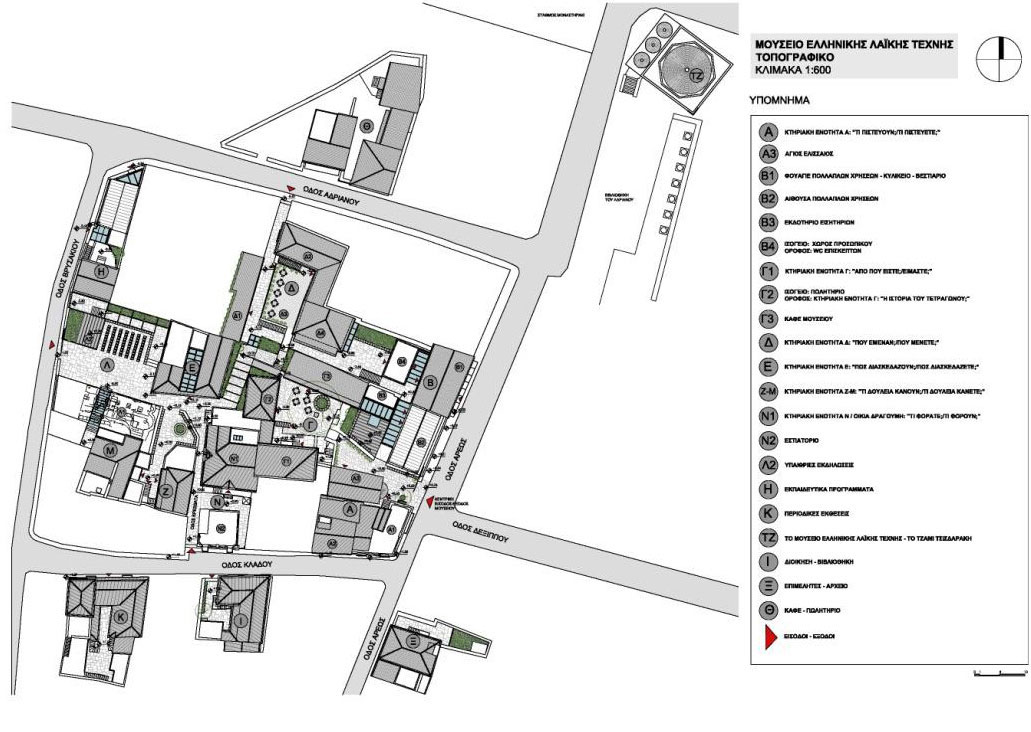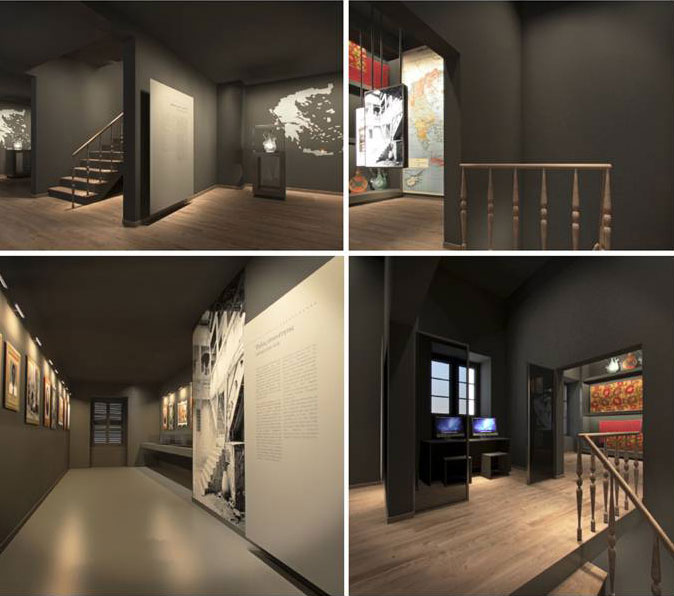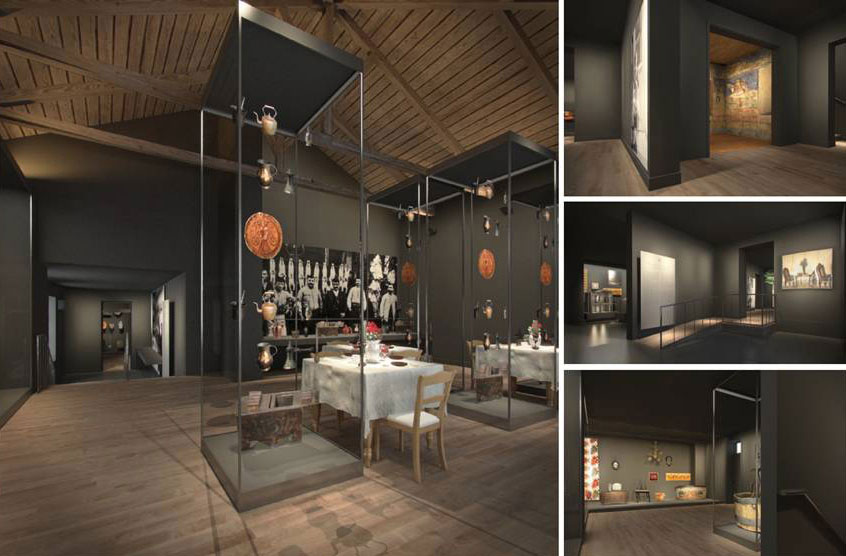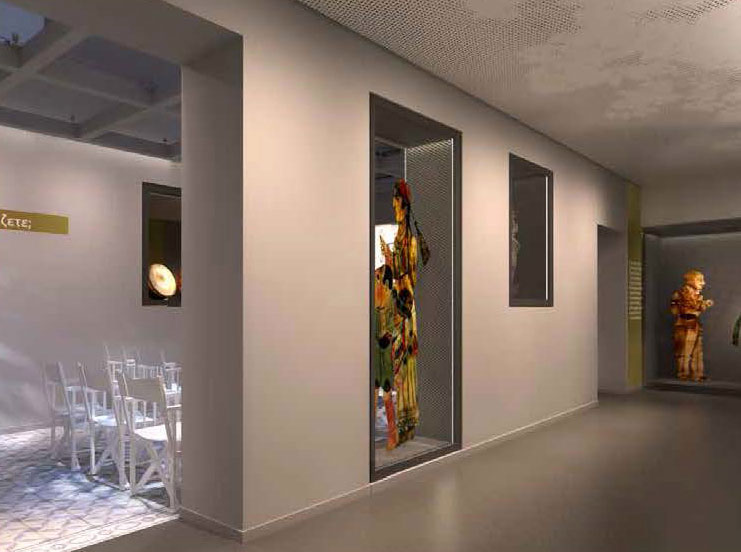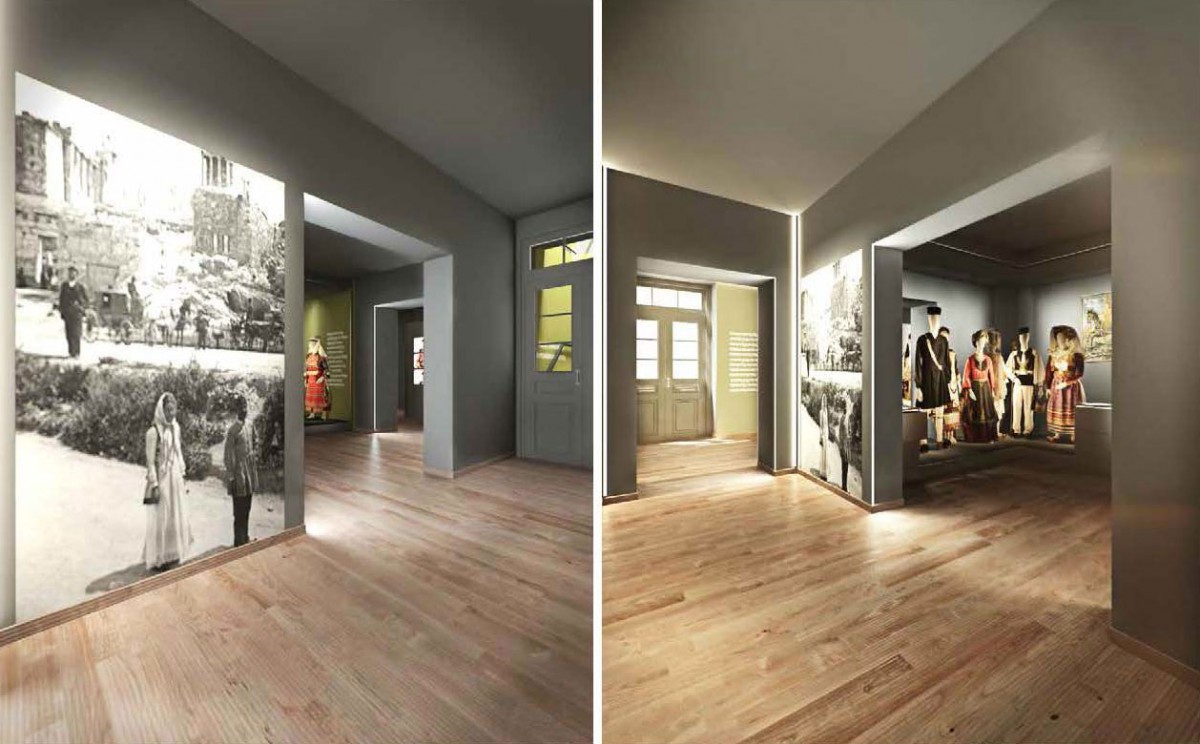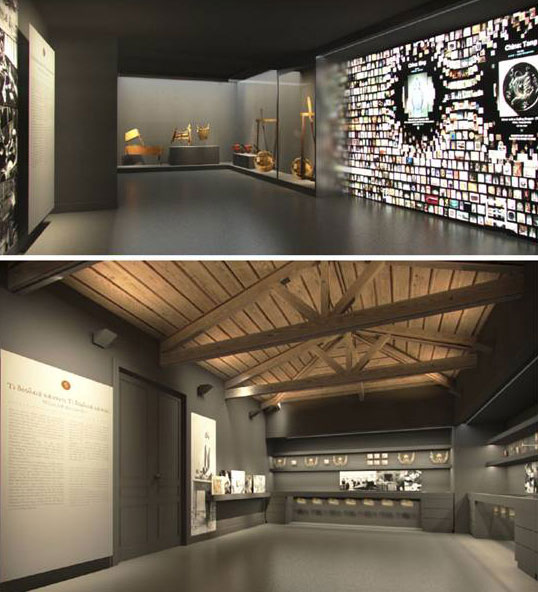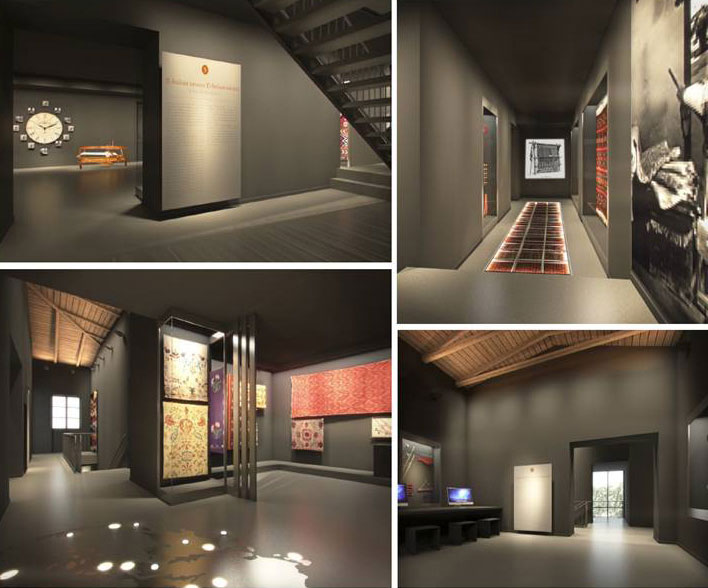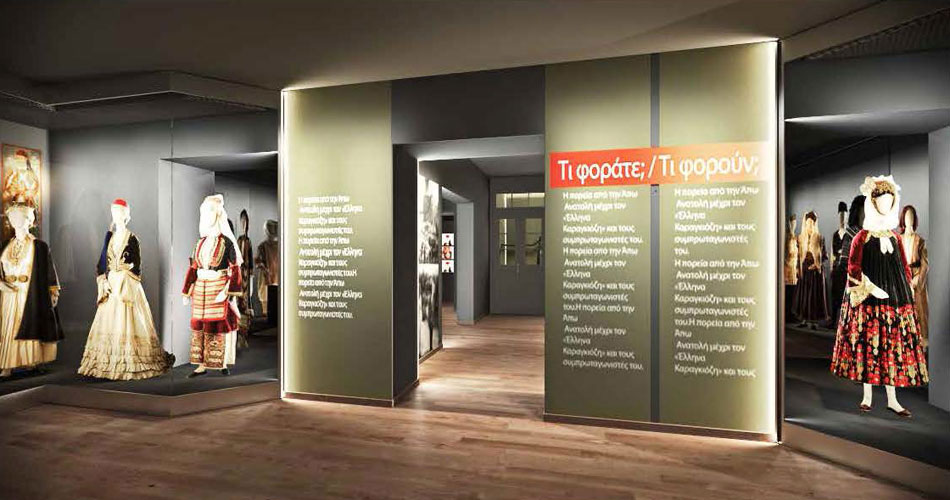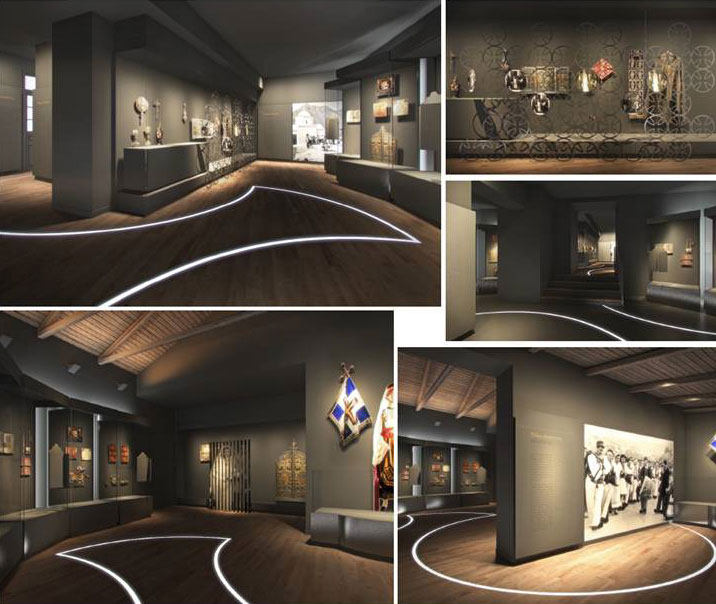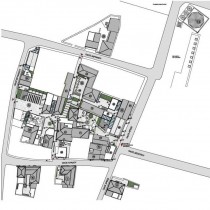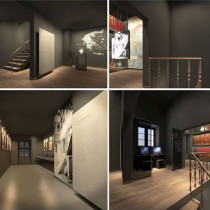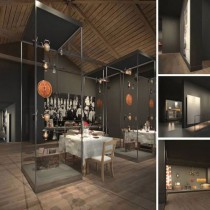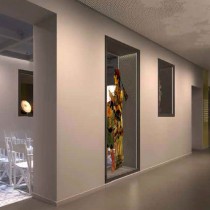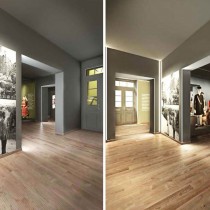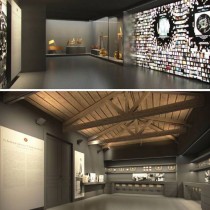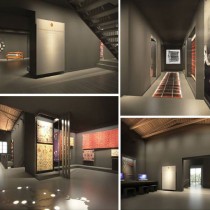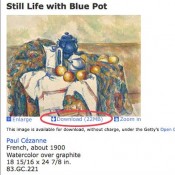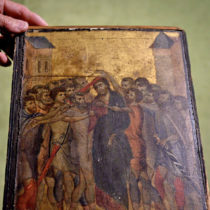In this article an outline is made of the museological study on the permanent exhibition of the Museum of Greek Folk Art (MGFA), the main Ethnographic Museum in the country as submitted to the Council of Museums and approved by them in December 2012. The dominant idea of the exhibition is mentioned, as well as the perceptions underlying its formulation, and the goals and points made in the thematic groups exhibited. Moreover, the study’s proposals are made in brief for the themes, structure, exhibits and the Exhibition’s interpretative means, as well as the process of its preparation.
Introductory observations
The study concerns the imminent relocation of the MGFA from the building on Kydathenaion Street in the Plaka where it shared premises from 1970 to the present, to a block on Areos, Adrianou, Vrysakiou and Kladou streets in Monastiraki. Reference is also made to the designing of a permanent exhibition in the “neighbourhood” defined by the streets mentioned above. This is an enclosed building complex of thirteen or more buildings round a central courtyard. From the end of the 18th century when the first buildings appeared “in the district of the Kato Pzari (Lower Bazaar), one of the oldest residential areas in Athens” up to the end of the 20th century when it came into the possession of the Ministry of Culture, “the block will incorporate building elements (and in some cases scattered ancient building material) of the late Ottoman period, elements of popular architecture and the new trend of Neoclassicism, thus constituting a unique example of continuity and adaptation in the urban fabric of Athens. At the same time, it will incorporate the following: elements from the late Roman wall, the church of Saint Thomas, a dedicatory church of the Benizelos family, the church of saint Elissaios, dedicatory church of the Logothetis family, later known for its services where Alexandros Papadiamandis and Alexandros Moraitidis participated as choristers and the Chomatianos-Logothetis mansion of the late Ottoman period”. Many of these elements are referred to and utilized in the study for the Museum’s permanent exhibition which unfolds in nine buildings of the complex. The rest of the buildings, including three nearby, located outside the block, serve for auxiliary functions of the museum and will not be referred to in the present article. Furthermore, the study’s proposals include the dismantling of the existing exhibition of ceramic art in the Tzisdaraki Mosque whose operation is the MGFA’s responsibility. The museum proposes that the museum be used for housing the first introductory section of the exhibition that concerns both the museum’s history and the museum itself.
A Framework for the Study’s organization and development
A working group was set up by the curators of the MGFA (note 1), a specialist museographer (note 2), the MGFA’s architect (note 3) and the authors of this article. This was necessary for the organizing and development of the study and the formulating of the dominant idea and its aims, developing the content and its structure, finalizing the location of the proposed exhibition sections in the buildings of the block and the study’s proposals to be initially included in the groundplans of the building units. In the context of a dynamic research process, the curators and the conservators explored the archives, the registers and storerooms of the MGFA and brought to light material evidence and documents containing sensational “stories” and, in many cases offer unique testimonies of modern Greek culture. This is a work of infrastructure that will be ongoing for some time and that will, as it seems, consistently serve the museum’s mission over time. The museum curators were also made responsible for investigating and developing the exhibition units: Each curator “adopted” a section of the exhibition for which he/she prepared a work text that included aims, ideas and proposals about its context. These texts were fully utilized in the drafting of the study and along with its main corpus was submitted to the advisory and sanctioning body of the Council of Museums.
The framework of the group’s work was research on historical documentation of the exhibition, the development of its topics as well as the finding of sources and archives to identify evidence that will constitute its visual material (note 4). Moreover the Museology laboratory of the Department of Cultural Technology and Communication of the University of the Aegean conducted on behalf of the Museum, a survey on the public aiming to collect key data on the relations of the museum with its potential visitors and explore their reactions regarding the goals and topics of the study. The results of the research speeded up the study and the related report was also submitted as an appendix to the museological study.
Last, we should note that a preliminary museological study had preceded the museological study and this had been approved by the Council of Museums in 2009. Several points in this present study are based on the preliminary one which had been the starting point of its working groups’ discussions.
The Exhibition’s rationale and predominant concept
The exhibition’s concept is based on the acknowledgement that people visit the museums to search for, recognize and confirm aspects of their individual and collective identity, to define and redefine their place in the world and, of course, to explore and discover facts about their cultural identity. Namely; what they share “in common” with their fellow humans as well as the facts that distinguish them from others, to provide insights, in general, to the “feeling of belonging”. The connection, moreover, of cultural heritage with the “concept” of identity has been successfully pointed out by most scholars of the museum phenomenon (note 5).
At the MGFA, the discussion on cultural heritage is part of the time frame of modern Greek culture. The “starting point” of this framework could be the Fall of Constantinople in 1453 that marks the virtual collapse of the Byzantine Empire and its replacement by the Ottoman. Many of the “realities”, however, of modern Greece have their roots in the Late Byzantine world and many of them have left their traces to this day. The exhibition includes references to the whole of this era, focusing, nevertheless, on the period between 1750 and 1960, the two centuries from which the vast majorities of the museum exhibits originate. A period, also, during which modern Greek culture establishes itself, flourishes and finally “through various circumstances that dictated respective adjustments and constant interactions with other cultural groups” (note 6) “resonates” in the “identity of today’s Greeks.
Taking all the above into consideration we were led to the following formulating of the exhibition’s concept which is reproduced in the goals and points made in all the sections of the exhibition: “Modern Greek Culture has contributed fundamentally in establishing the identity of the Greeks-it is their/our immediate past” and “Greeks can discover important aspects of their identity in their modern cultural heritage”. Analyzing the concept led us to particular questions which are dealt with and given some initial answers by the exhibition’s topics. These are: “Who are we? Who are the Modern Greeks/ What is Modern Greece? And how has the recent past contributed to establishing its identity? How was Modern Greek Culture established? What is its historical framework? What influences have shaped it? Which are its “institutions”? How is it perceived either by Greeks or foreigners? What are the creations of Modern Greece and how are the many aspects of its identity “captured” in these creations whether tangible or intangible? What is so-called “Folk Art” and what are its characteristics?” The above goals are also dictated by the survey of public opinion which demonstrates a dire need to outline modern Greek culture: while it is the “recent” past for today’s Greeks, it remains “a total stranger” for a considerable part of the population. The informants participating in the survey also pointed out the need to place the “objects” displayed in museums in their cultural context as well as the need to link to the present those issues dealt with by the exhibition.
Basic interpretative strategies
For a start it should be noted that the study endorses the basic principles on communication and learning in places of informal learning and cultural references that are now a commonplace when talking about the new type of museum internationally (note 7). Therefore, while for the time being, the MGFA’s permanent exhibitions are primarily “centered round objects” and of a static nature, in the new exhibition the interest will revolve round people and the experience we would wish them to gain from their visit to the museum. Based on this logic we propose the “creation” of a Contemporary Museum, governed by the principles of an experiential approach, “recreational education” and renewability, where modern Greek culture will be enhanced as a whole through the perspective both of tangible and intangible cultural inheritance; the museum as a bearer/transmitter of social change and development, committed to approaching a larger public and boldly claiming its place in an “industry of leisure time”, a museum that is interdisciplinary, politically aware and possibly reflective. The results of public survey referred to above confirms the correct choice of this approach. Second and equally important is the study of museological representations that aims at the visualization of ideas and perceptions explored both by contemporary folklore and anthropology (note 8). Therefore we propose to create an exhibition that highlights, amongst other things, the historical dimension of social phenomena and the different aspects of the cultural systems it deals with. It will also include facts on rural as well as urban populations with whatever problems are entailed in the effort to define the urban class in modern Greek society (note 9). It will create connections between thematic units, it will highlight, at every opportunity, the historical framework as a “backdrop” to the exhibition of objects, it will talk about the role of the past in shaping the present, it will refer to cultural practices that are evolving and surviving, encouraging “critical” emotion, reflection and humour.
Sections of the Exhibition
The exhibition will be structured and unfold in three introductory sections and five displaying the main theme. All the sections of the exhibition will be located in the buildings of the block except for the introductory section that will be in the Tzisdaraki Mosque opposite the block’s building complex. The sections are the following (fig. 1):
-Introduction: a) The Museum of Greek Folk Art and the Tzisdaraki Mosque, b) The history of the block, c) Where are you from? / Where are we from? – The origins of Modern Greece
-Main topic: a) Where do they live? / Where do you live? – The home and the cycle of life, b) How do they enjoy themselves? / How do you enjoy yourselves?-Hellenism of the recent past and Recreation, c) What work do they do/ What work do you do? ‒Work and Employment, d) What do they wear? / What do you wear? –Dress and Adornment, e) What is their faith? / What is your faith? – Religion – beliefs- customs and traditions
General comments
-The titles of six topics have been formed as questions so as to stimulate the visitors’ interest and focus on key points made by the exhibition. The use of more than one “person” as well as different tenses-present, historical present – wishes to “remind” the visitor both of his relations to his “immediate” past and ancestors but also of the history of the topics dealt with in the exhibition (note 10).
-The themes of the exhibition try to approach most aspects of modern Greek culture. The latter make up facets of the identity of the people who lived both in the centuries explored by the exhibition’s content as well as Greece’s citizens of today. In several cases the possibility of developing themes in the Museum’s future programmes are simply hinted at and enhance its great potential. The themes developed foremost are those that relate to an in depth “analysis” of the objects in the collection.
-The study tries to keep a balance between interpretative means based on digital technology and more conventional choices (objects, static/mechanical exhibits, scenic representations, texts etc.). It also attempts to display and highlight the greatest possible number of objects from the MGFA’s extremely rich collection.
-As part of the communication policy adopted by the study, the interpretative means proposed support interactivity, participation, the “narration of stories” aimed at activating critical thought, strong emotions, social intercourse (note 11) and the visitor’s “empowerment” (note 12).
The discussion that follows on the basic statements made in each section of the exhibition, concerns the realization of the main concept and the exhibition’s overall targets in different places of interest within the framework of the exhibition narrative.
Structure, statements, themes and interpretative means in the exhibition sections (indicatively)
INTRODUCTION
a) The Museum of Greek Folk Art and the Tzisdaraki Mosque
The first section of the introduction unfolds inside the monument known as the Tzisdaraki Mosque. This site is a proper choice as the monument first housed the Museum and is an integral part of its history. Displayed in the section are representative objects from all the MGFA’s collections, representative objects from different periods of the Museum’s collecting activities as well as much archive material. Also to be found there are the sub-sections History of the Monument, History of the Museum, the Curators’ Choices and the treasures of the MGFA.Summing up the section’s basic statements we can conclude with the following:
-The “Tzisdaraki Mosque” constitutes a “landmark” of Monastiraki Square.
-“Moments” from the monument’s history are linked to the history and development of the city of Athens
-The founding of the MGFA reflects the national and political ideology of the early 20th century.
-The history of the Museum’s development “reveals” the principles of the collecting policy, the cultural policy and cultural management that governs the Museum’s operation over different periods of time.
-The Museum’s collections originate from whichever regions were/are inhabited by Greeks.
-The Museum’s collections include some of the most representative examples of the so- called popular material culture and these highlight “Folk art” in all its glory.
In order to address the above, this section of the exhibition includes facts on the Museum’s history and philosophy, the historical and cultural framework of all the years of the Museum’s operation, the collections of the Museum and the processes of acquiring them, the different operations of the Museum over time, the monument housing the Museum and the former’s history, the modern history of the city of Athens, particularly of its historical centre. The section also includes the following interpretative means: a digital interactive exhibit that presents aspects of history and facts about the architecture of an important monument from the history of Greece’s recent past and a composition of display cases with objects from the museum collection and archive material (extracts from the minutes of the Museum’s board of directors, administrative documents, press releases, Greek Government Gazette issues, invoices, testimonies, photographs, documentation charts, etc.) Included in the display are objects that are evidence of the procedures followed to acquire sets of collections, the missions undertaken by the Museum to collect examples from Greece, the donations made to the Museum etc., as well as the archive material that outlines the conditions, the reasoning, the ways in general by which the Museum collections were acquired (e.g invoices, contracts, publications, testimonies etc.). These facts are displayed next to or above the objects. The exhibits aim to playfully initiate the visitor into the “secrets” of the “philosophy” and history of the Museum from its founding to our times as well as to the “sanctuary” of the museum’s work backstage. The exhibits also wish to link the museum’s history with the broader framework both historical, social, political, economic and cultural in the years of its operation, to link the Museum’s history with the monument housing it and last for them, the exhibits, to be an introduction and framework for the sections of the exhibition the visitor will explore through the buildings on the block.
b) The history of the block
The second introductory section of the exhibition is located in one of the first buildings the visitor encounters on entering the block. The section deals with facts about the MGFA’s new premises. The themes of this section unfold through digital productions and conventional visual material. On display, however, are also a handful of representative objects “discovered” on the block when its buildings were being cleaned and about to be restored. The section hosts the following sub sections: The room with the portraits, “Games” in the courtyard, Athens.
As the basic statements of this section we should mention the following:
-The history of the block “is consistent” with the history of the “rebirth” of the city of Athens.
-The historical, social and cultural framework of the block’s development in different periods represents the historical, social and cultural framework of the development, in respective periods, of Athens’ historical centre – the block’s little “community” constitutes a miniature of Greek Society of the recent past and particularly that of Athens.
-The block constitutes a “monument” of the capital’s architecture and urban planning from the recent past, one of only a handful surviving.
-The block constitutes the ideal premises for the Museum and for the memories of the culture of the recent past that it addresses.
-The “symbolic” return of the block’s residents to the houses expropriated from them for the project’s sake, fulfills the Museum’s social role.
The exhibition, in this section includes facts on the history and architecture of the buildings of the block and the surrounding area, the families that lived there in different periods, the architecture and urban development of the city of Athens and particularly of its historical centre from the late period of Ottoman rule up to the first decades of the 20th century. The following interpretative means are suggested for this section: A combination of actual exhibits (photographs, portraits of individuals who lived on the block) with audiovisual productions and a digital interactive setup, whose content is projected when the visitor activates it participating in a simulated “courtyard game”. The exhibits try to initiate the visitor into the daily life of a typical Athenian neighbourhood of the past through the personal stories of its residents and to demonstrate the development and changes of the Capital’s historical centre over approximately two centuries.
c) Where are you from? / Where are we from? ‒ The origins of Greece of the recent past (fig. 2)
The exhibition’s last introductory section constitutes the transition to its principle theme. Representative objects from most of the Museum’s collections are displayed in this section, such as ceramic objects, secular and ecclesiastical wood sculpture, woven and embroidered objects, metal work, secular and ecclesiastical silverware, tools of traditional trades and costumes. Also housed here are the two sub sections, the Historical framework of the Greek Culture of the recent past and the “countries” of Hellenism. The basic statements of this section are briefly formulated as follows:
-The place of origin is a basic component of a person’s identity.
-The geographic and cultural boundaries of Modern Greece go far beyond the present day borders of the independent Greek state.
-Each region’s cultural context has decisively influenced manifestations of modern Greek culture, both tangible and intangible.
-The roots of Hellenism of the recent past date back to its historical background.
The themes of the section include facts on the areas which Greeks had inhabited and originated from, the cultural influences that shaped Greek culture of the recent past, its roots and historical framework, Hellenism of the diaspora, immigration. The interpretative means of this section are mainly digital interactive exhibits in which visitors discover facts about the country’s recent past, that past’s relations with global history, local communities and possibly their homelands as appearing on the map of Hellenism at large but also where they give facts, if they wish to do so, about their own “identity”. In this section the exhibits “converse” with selected objects from the museum collections that carry memories of their own country of origin. All of the interpretative means try to demonstrate the synthesis of the historical framework with material culture, to include visitors in the exhibition’s narrative and to encourage social interaction in the exhibition space.
THE MAIN THEME
a) Where do they live? / Where do you live? ‒ Home and the cycle of life (fig. 3)
The first section of the main theme is located in two buildings and displays traditional objects from most of the museum collections; ceramic objects, secular wood carving, weaving, embroidery, metalwork, secular silverwork, paintings and costumes. It also houses the following sub sections: The shell of the home and public life, Raw materials, The natural environment and the professional builders, “The Cycle of Life “ and Life at home, Theofilos’ room, The “mosaic” of the city, The family at table. Some of the basic statements made in this section include the following:
-The home (the traditional Greek home) and the activities taking place inside it, express the individual, social, economic and in general cultural identity of man.
-In the home (the traditional Greek home) man’s basic needs are served and basic functions are performed-protection from the environment, nourishment, hygiene, sleep, work.
-For the most part, an individual’s identity is shaped and family bonds develop within the traditional Greek home.
-Traditional practices and attitudes related to regional life, inside and outside the home, are transferred to the cities.
-Conversely, trends and practices developing in the cities influence the appearance of the traditional home and everyday practices in general.
Included in the section’s large variety of themes are facts on the typology and architecture of groups of settlements found from the Ottoman times to the mid 20th century, the depiction of social stratifications in the architecture of various groups of settlements, the relation between building and the environment in each region, new materials, cultural influences that building has been susceptible to in different periods of history, the social and financial conditions and the techniques of building etc, daily life in various types of traditional homes, the interior decoration of various types of home, nutrition and nutritional habits in different regions and different social classes, customs related to building a house and everyday living. Digital exhibits with 3D representations of buildings, “dollshouses” designed as the interiors of traditional houses, a digital table that is “layed” according to the visitor’s choices, ambient sounds and “whispers” from the depths of “domestic” daily routine, a scenic representation of the interior of a town house from the 20th century, many objects from the MGFA’s collections etc., aim at relating the architecture of different types of home to their cultural framework and their various owners, to initiate the visitor into the “depths” of the daily routine of people belonging to the period examined by the exhibition, to demonstrate the preservation of practices that are “nostalgically” recreated in 20th century town houses, to present the nutritional habits of Greeks and the ritual of eating through the ages.
b) How do they enjoy themselves? / How do you enjoy yourselves?-Hellenism of the recent past and Recreation (fig. 4, 5)
Principally shown in the second section of the main theme are objects from the collection of the Shadow Theatre as well as objects from the collections of musical instruments and disguises. Also on display are a few objects related to the “rituals” of festivals, ceremonies and costume and therefore objects from collections of ceramics, secular woodcarving, metalwork, secular and ecclesiastical silverware and costume. The section hosts the subsections of the Shadow Theatre and its principal hero Karagiozis, the “paths” of East and West in forms of entertainment. The statements made in this section are as follows:
-Customs and traditions related to the recreation of Greeks of the recent past date from the times of Ottoman rule.
-Customs and traditions related to recreation are related to the cycle of feast days in the Orthodox Church.
-Popular traditions related to recreation influence and are also influenced by corresponding ones in Europe.
-Traces of many popular traditions can be distinguished in types of recreation in modern Greek culture.
-Karagiozis is the most popular Folk theatre and the most popular form of recreation up to the mid 20th century.
As to its themes, the section includes facts about Karagiozis and the Popular Shadow Theatre from the time of Ottoman rule till today and other forms of entertainment encountered in Greek traditional society but also in city “culture” such as festivals, wakes, baths, walks, visits, church going, cafes etc. A short film, digital interactive exhibits, the scenic representation of the berdes (curtain), digital frames, sounds and light that creates the “game of shadows” as well as the MGFA’s extremely rich collection of objects from the Shadow Theatre, all of the above constitute the interpretative means aiming to initiate the visitor into forms of entertainment in Greek Culture of the recent past some of which live on to our times.
c) What work do they do?/ What work do you do? ‒Work and Employment (fig. 6, 7)
The section referring in general to aspects of men and women’s work in Greek culture of the recent past evolves in two buildings on the block. In fact, after several discussions we ended up including women’s employment, often “neglected” in museum narratives (note 13), in the larger building of the two.
Displayed in the “men’s building” are objects mainly from the tool collection of so- called traditional trades as well as “products” of these trades. Also displayed in its rooms are the sub sections called Professions and Employment of the recent past, and the Workshop Crafts. Mainly displayed in the “women’s building” are exhibits from the collection of tools and creations of the arts of embroidery and weaving. Also located there are the sub sections called a) the Hostesses, b) From the weaving material to the woven object, c) Greek Embroideries and d) the School of embroidery. The following statements come respectively from the two building complexes:
-The so-called Folk Culture is “produced” and primarily develops within the framework of traditional Greek communities and their economic, work related and cultural repercussions in general.
-The so- called folk culture is produced and developed by people working mainly in the primary and secondary but also in the tertiary work sector.
-Traditional work produces items for “subsistence” but also for commerce.
-So-called folk art produces mainly articles for use and products of traditional labour.
-In traditional Greek communities women play an important part in work. Weaving and embroidery are basically female work and belong to cottage industry.
-Cottage industry produces a large part of the house’s necessary equipment, part of the materials necessary for work outside the home, as well as fulfilling the needs of dress.
-The artifacts of weaving and cottage industry are the expression of a woman’s identity and creativity.
-The artifacts of weaving and embroidery are influenced by the historical and cultural framework in which they are created.
-Embroidery is one of the richest branches of folk art.
-At given moments of history, cottage industry is transformed into light manufacture.
Data on traditional work in the primary sector of production-professions, techniques, products, utilizing raw materials and environmental conditions, work in the secondary sector of production-professions, techniques, products, guilds, work in the tertiary sector of production, the profile of Greek professionals over the centuries the exhibition is addressing, professional and social mobility, education, apprenticeship in professions etc. All the above constitute the themes of the men’s building. A multitouch “Wall” of large dimensions is activated by the visitor’s “touch” and revealing the stories of many generations of people occupied in different work sectors, as well as abstract scenic representations of workshops, archive material and objects, sounds of work and talking etc., all make up a complex environment and aim to present some of the conditions and results of work during the centuries addressed by the exhibition.
In the “women’s building”, the theme includes facts on the materials, the tools and techniques used for weaving, their decorative motifs, the role of women in the family, the community and the cultural framework in which the textiles were created, their artistic value, the evolution of weaving from a domestic to a workshop craft, the art of embroidery and the cultural influences it receives from different regions of Greece. “Clever” installations, digital interactive exhibits that “instruct” the visitor in the art of embroidery, short videos that relate the course starting from raw materials to the production of textiles, a variety of objects and printed visual material address the statements and themes of this exhibition section.
d) What do you wear? / What do they wear? ‒ Dress and Adornment (fig. 8)
In the fourth section of the main theme, exhibits from the costume collection are mainly displayed with costume accessories and jewelry owned by the MGFA. Also hosted are the following sub sections: We and our Clothes, Costume in time and space, Dressed in our best, Dress accordingly, Magic clothes, One must suffer to be beautiful, and Creating costumes. This section’s basic statements are the following:
-Traditional costume reveals an individual’s personal and social characteristics.
-Traditional costume reveals a person’s place of origin.
-Traditional costume reveals the cultural framework from which it comes and its influences.
-The origins of Greek traditional costume date back to Byzantium and the Ottoman period.
-Traditional costumes are the basic clothes of the inhabitants from all over Greece for more than two centuries.
The issues addressed by this section concern the historical development of costume in Greece, the basic principles of dress and adornment in various regions of Greece during the recent past, the geographic origins of local costume and its cultural context, the code of costumes, the use of different types of costume, the production of costume etc. The above themes emerge through stories that are “hidden” in cupboards and drawers, interactive exhibits that invite the visitor to “dress” in traditional clothes, either virtual or real and to call upon the “magic power” of symbols, a short video about dress and its difficulties, printed visual material and of course many samples from the MGFA’s very rich collection of costumes that outline for the visitor the many aspects of the history of costume and its importance.
e) What is their faith? / What is your faith? – Religion-beliefs-customs and traditions (fig. 9)
This section is located in the building that is directly next to the church of Saint Elissaios. Displayed in this section are mainly exhibits from the collection of ecclesiastical silverware, embroidery, dress, woodcarving and ceramics. Also to be found here are the following sub sections: The religion of Modern Greece and the Greek Orthodox Church, “Sweet Virgin Mary Good Night….”, the holy mysteries and the cycle of life and Saint Elissaios. This section is constructed round the following statements:
-Religious feeling has been central to public life in Greek communities of the recent past.
-The Greek Orthodox Church was an important part of the social and spiritual life led under Ottoman rule and after.
-The Greek Church of more recent years upholds and preserves the Byzantine ritual.
-The Greek Christian Church has many bonds with a pre Christian past, old pagan beliefs and age old customs infiltrate the most sacred moments of Christian religion.
-The presence of the Church in the cycle of life of the Greeks is very important (note 14).
The section presents facts on the history, the organization and the activities of the Greek Orthodox Church, the ritual involving the carrying out of the “official acts” of the Church, the ritual regarding the carrying out of the mysteries, the “relationships” of the “religions” with magic and overall that of “Christianity” with the “prechristian”, the “encounter” of ecclesiastical events with folk traditions and the overall secularism of church ritual, other dogmas in the Greek world of the recent past as well as facts on the Church of St Elissaios. A digital exhibit that demonstrates the development in time and space of the Greek Orthodox Church from its formation up to and including the 20th century, together with other dogmas worshipped in Greece at large, melodies and sounds, items of worship, photographs of mysteries, paintings, the semantic representation of Christian symbols etc., all the above make up an environment that aims at initiating the visitor into the secrets of worship in the Greek Orthodox Church as well as its secularism in the field of everyday life.
The next step, in place of an epilogue…
This museological study, is the first of three stages that over the next years will lead to the exhibition’s realization. This was followed by a museographic study encompassing a study of the exhibition lighting, the design of the surrounding space and the printed visual material as well as the implementation study at present being completed. The formulation of the technical bulletin and tender documents will be based on the implementation detail study in order for competitions to be announced and contractors chosen for the project’s realization. These studies naturally diverge from the original museological study-subsections, have merged or have been renamed and in some cases new ones have been formed. The exhibits’ description was finalized, materials, constructions and media were analyzed in every detail, and a final selection was made of objects under conservation for them to participate in the exhibition. All the above remain, however, consistent with the museological study of 2012 regarding the exhibition’s concepts, aims and statements, its structure into basic sections and the important interpretative means used in each of them.
Elena Melidi, Historian-Archaeologist, Deputy Head of the Museum of Greek Folk Art
Alexandra Nikiforidou, Researcher-Museologist, Museum Consultant
